Shirin Saeedi Bidokhti
Generative Diffusion Models for Resource Allocation in Wireless Networks
Apr 28, 2025Abstract:This paper proposes a supervised training algorithm for learning stochastic resource allocation policies with generative diffusion models (GDMs). We formulate the allocation problem as the maximization of an ergodic utility function subject to ergodic Quality of Service (QoS) constraints. Given samples from a stochastic expert policy that yields a near-optimal solution to the problem, we train a GDM policy to imitate the expert and generate new samples from the optimal distribution. We achieve near-optimal performance through sequential execution of the generated samples. To enable generalization to a family of network configurations, we parameterize the backward diffusion process with a graph neural network (GNN) architecture. We present numerical results in a case study of power control in multi-user interference networks.
Decentralized Learning Strategies for Estimation Error Minimization with Graph Neural Networks
Apr 04, 2024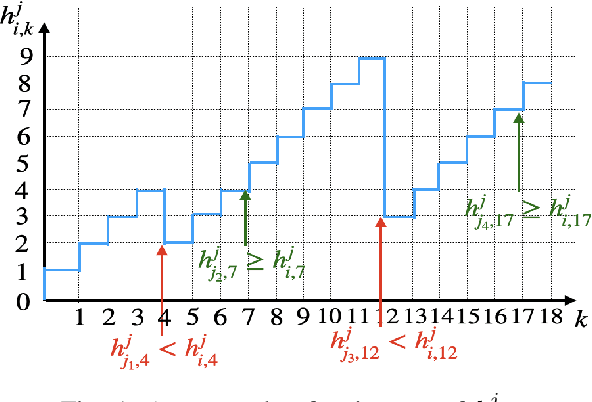
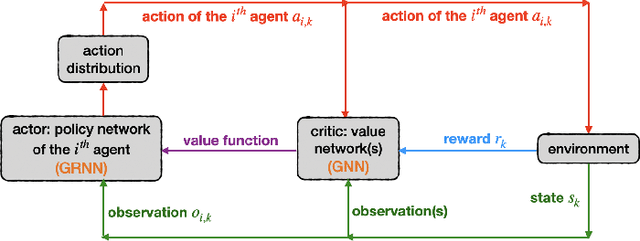
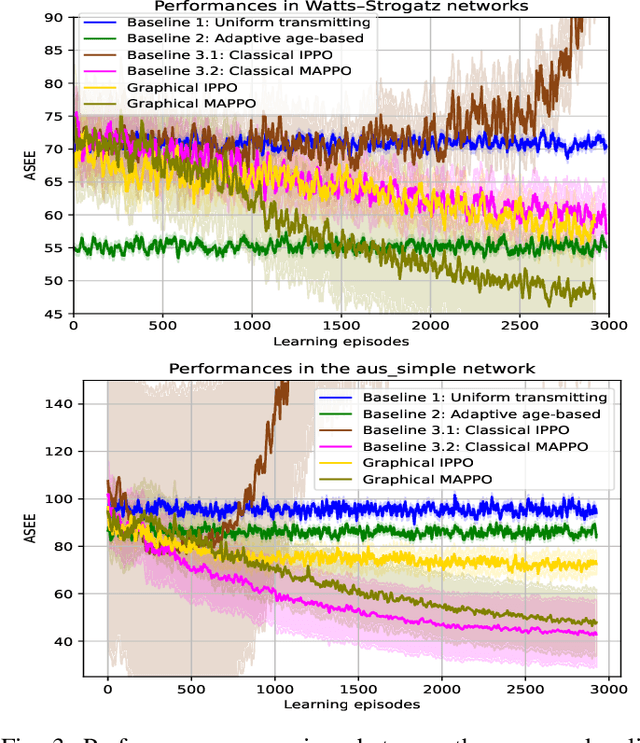
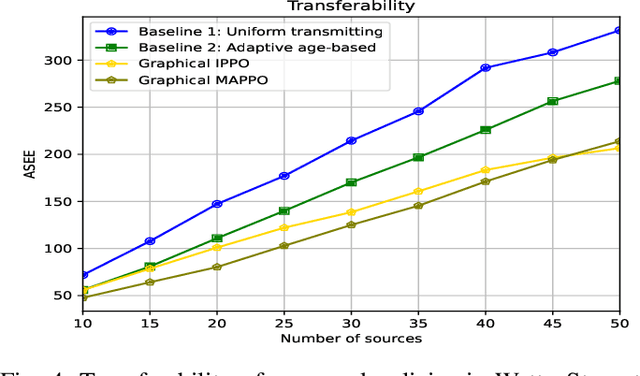
Abstract:We address the challenge of sampling and remote estimation for autoregressive Markovian processes in a multi-hop wireless network with statistically-identical agents. Agents cache the most recent samples from others and communicate over wireless collision channels governed by an underlying graph topology. Our goal is to minimize time-average estimation error and/or age of information with decentralized scalable sampling and transmission policies, considering both oblivious (where decision-making is independent of the physical processes) and non-oblivious policies (where decision-making depends on physical processes). We prove that in oblivious policies, minimizing estimation error is equivalent to minimizing the age of information. The complexity of the problem, especially the multi-dimensional action spaces and arbitrary network topologies, makes theoretical methods for finding optimal transmission policies intractable. We optimize the policies using a graphical multi-agent reinforcement learning framework, where each agent employs a permutation-equivariant graph neural network architecture. Theoretically, we prove that our proposed framework exhibits desirable transferability properties, allowing transmission policies trained on small- or moderate-size networks to be executed effectively on large-scale topologies. Numerical experiments demonstrate that (i) Our proposed framework outperforms state-of-the-art baselines; (ii) The trained policies are transferable to larger networks, and their performance gains increase with the number of agents; (iii) The training procedure withstands non-stationarity even if we utilize independent learning techniques; and, (iv) Recurrence is pivotal in both independent learning and centralized training and decentralized execution, and improves the resilience to non-stationarity in independent learning.
Approaching Rate-Distortion Limits in Neural Compression with Lattice Transform Coding
Mar 12, 2024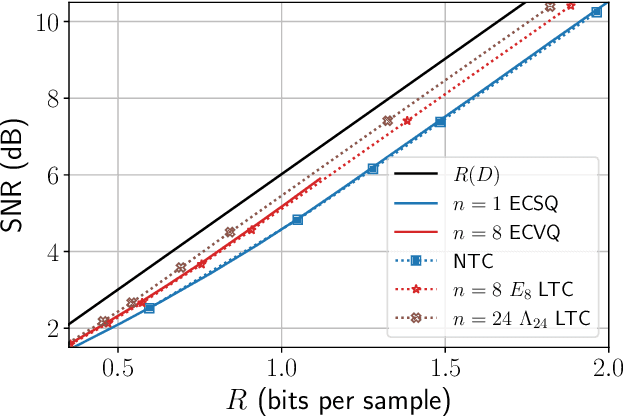
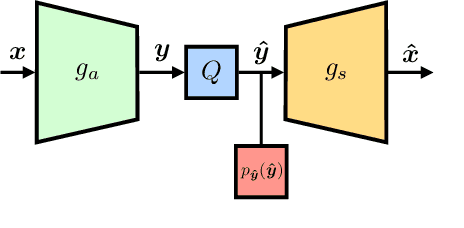
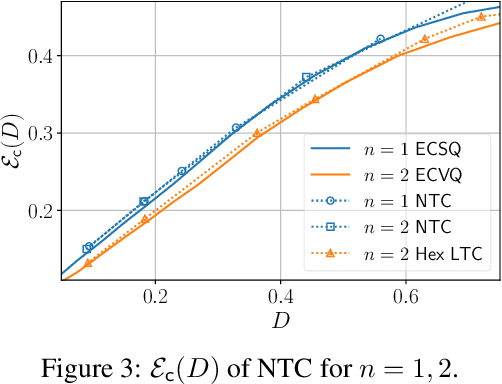
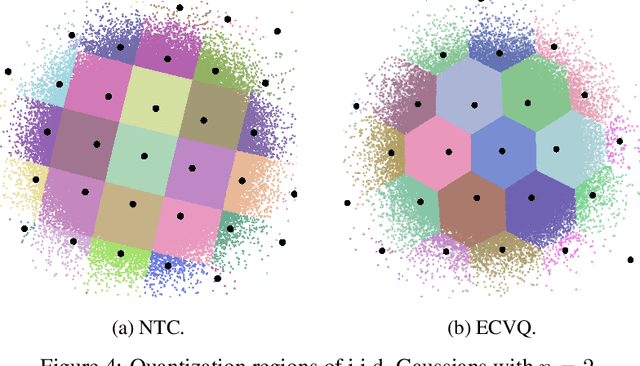
Abstract:Neural compression has brought tremendous progress in designing lossy compressors with good rate-distortion (RD) performance at low complexity. Thus far, neural compression design involves transforming the source to a latent vector, which is then rounded to integers and entropy coded. While this approach has been shown to be optimal in a one-shot sense on certain sources, we show that it is highly sub-optimal on i.i.d. sequences, and in fact always recovers scalar quantization of the original source sequence. We demonstrate that the sub-optimality is due to the choice of quantization scheme in the latent space, and not the transform design. By employing lattice quantization instead of scalar quantization in the latent space, we demonstrate that Lattice Transform Coding (LTC) is able to recover optimal vector quantization at various dimensions and approach the asymptotically-achievable rate-distortion function at reasonable complexity. On general vector sources, LTC improves upon standard neural compressors in one-shot coding performance. LTC also enables neural compressors that perform block coding on i.i.d. vector sources, which yields coding gain over optimal one-shot coding.
Text + Sketch: Image Compression at Ultra Low Rates
Jul 04, 2023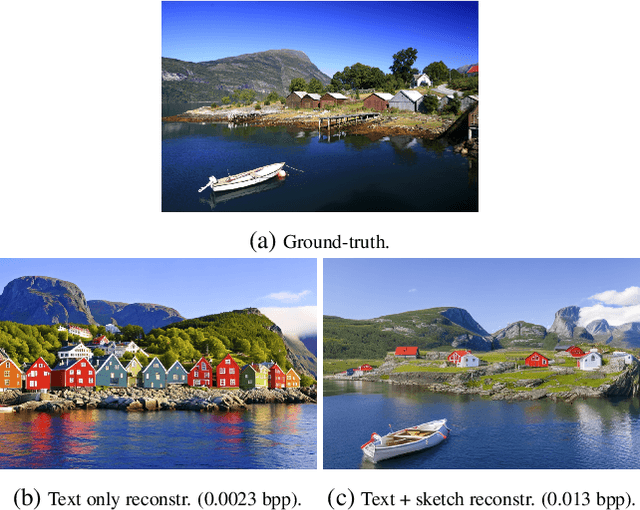



Abstract:Recent advances in text-to-image generative models provide the ability to generate high-quality images from short text descriptions. These foundation models, when pre-trained on billion-scale datasets, are effective for various downstream tasks with little or no further training. A natural question to ask is how such models may be adapted for image compression. We investigate several techniques in which the pre-trained models can be directly used to implement compression schemes targeting novel low rate regimes. We show how text descriptions can be used in conjunction with side information to generate high-fidelity reconstructions that preserve both semantics and spatial structure of the original. We demonstrate that at very low bit-rates, our method can significantly improve upon learned compressors in terms of perceptual and semantic fidelity, despite no end-to-end training.
On a Relation Between the Rate-Distortion Function and Optimal Transport
Jul 01, 2023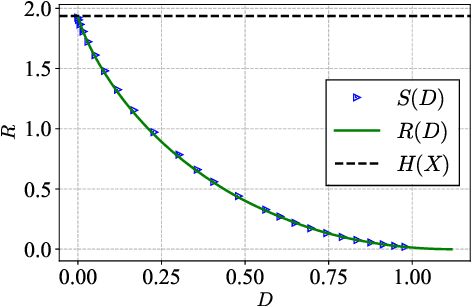
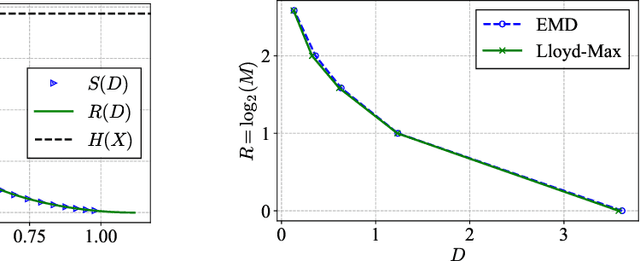
Abstract:We discuss a relationship between rate-distortion and optimal transport (OT) theory, even though they seem to be unrelated at first glance. In particular, we show that a function defined via an extremal entropic OT distance is equivalent to the rate-distortion function. We numerically verify this result as well as previous results that connect the Monge and Kantorovich problems to optimal scalar quantization. Thus, we unify solving scalar quantization and rate-distortion functions in an alternative fashion by using their respective optimal transport solvers.
Federated Neural Compression Under Heterogeneous Data
May 25, 2023



Abstract:We discuss a federated learned compression problem, where the goal is to learn a compressor from real-world data which is scattered across clients and may be statistically heterogeneous, yet share a common underlying representation. We propose a distributed source model that encompasses both characteristics, and naturally suggests a compressor architecture that uses analysis and synthesis transforms shared by clients. Inspired by personalized federated learning methods, we employ an entropy model that is personalized to each client. This allows for a global latent space to be learned across clients, and personalized entropy models that adapt to the clients' latent distributions. We show empirically that this strategy outperforms solely local methods, which indicates that learned compression also benefits from a shared global representation in statistically heterogeneous federated settings.
Neural Estimation of the Rate-Distortion Function With Applications to Operational Source Coding
Apr 04, 2022
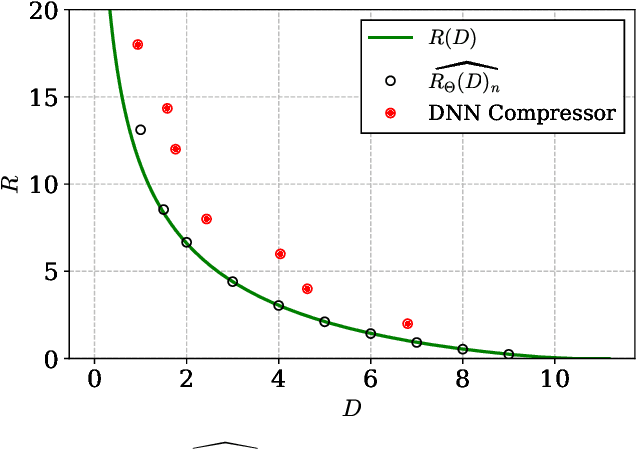


Abstract:A fundamental question in designing lossy data compression schemes is how well one can do in comparison with the rate-distortion function, which describes the known theoretical limits of lossy compression. Motivated by the empirical success of deep neural network (DNN) compressors on large, real-world data, we investigate methods to estimate the rate-distortion function on such data, which would allow comparison of DNN compressors with optimality. While one could use the empirical distribution of the data and apply the Blahut-Arimoto algorithm, this approach presents several computational challenges and inaccuracies when the datasets are large and high-dimensional, such as the case of modern image datasets. Instead, we re-formulate the rate-distortion objective, and solve the resulting functional optimization problem using neural networks. We apply the resulting rate-distortion estimator, called NERD, on popular image datasets, and provide evidence that NERD can accurately estimate the rate-distortion function. Using our estimate, we show that the rate-distortion achievable by DNN compressors are within several bits of the rate-distortion function for real-world datasets. Additionally, NERD provides access to the rate-distortion achieving channel, as well as samples from its output marginal. Therefore, using recent results in reverse channel coding, we describe how NERD can be used to construct an operational one-shot lossy compression scheme with guarantees on the achievable rate and distortion. Experimental results demonstrate competitive performance with DNN compressors.
Robust Graph Neural Networks via Probabilistic Lipschitz Constraints
Dec 14, 2021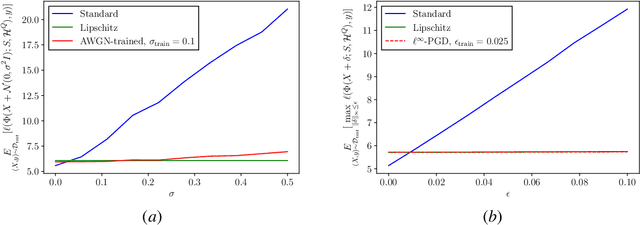


Abstract:Graph neural networks (GNNs) have recently been demonstrated to perform well on a variety of network-based tasks such as decentralized control and resource allocation, and provide computationally efficient methods for these tasks which have traditionally been challenging in that regard. However, like many neural-network based systems, GNNs are susceptible to shifts and perturbations on their inputs, which can include both node attributes and graph structure. In order to make them more useful for real-world applications, it is important to ensure their robustness post-deployment. Motivated by controlling the Lipschitz constant of GNN filters with respect to the node attributes, we propose to constrain the frequency response of the GNN's filter banks. We extend this formulation to the dynamic graph setting using a continuous frequency response constraint, and solve a relaxed variant of the problem via the scenario approach. This allows for the use of the same computationally efficient algorithm on sampled constraints, which provides PAC-style guarantees on the stability of the GNN using results in scenario optimization. We also highlight an important connection between this setup and GNN stability to graph perturbations, and provide experimental results which demonstrate the efficacy and broadness of our approach.
Out-of-Distribution Robustness in Deep Learning Compression
Oct 13, 2021



Abstract:In recent years, deep neural network (DNN) compression systems have proved to be highly effective for designing source codes for many natural sources. However, like many other machine learning systems, these compressors suffer from vulnerabilities to distribution shifts as well as out-of-distribution (OOD) data, which reduces their real-world applications. In this paper, we initiate the study of OOD robust compression. Considering robustness to two types of ambiguity sets (Wasserstein balls and group shifts), we propose algorithmic and architectural frameworks built on two principled methods: one that trains DNN compressors using distributionally-robust optimization (DRO), and the other which uses a structured latent code. Our results demonstrate that both methods enforce robustness compared to a standard DNN compressor, and that using a structured code can be superior to the DRO compressor. We observe tradeoffs between robustness and distortion and corroborate these findings theoretically for a specific class of sources.
 Add to Chrome
Add to Chrome Add to Firefox
Add to Firefox Add to Edge
Add to Edge